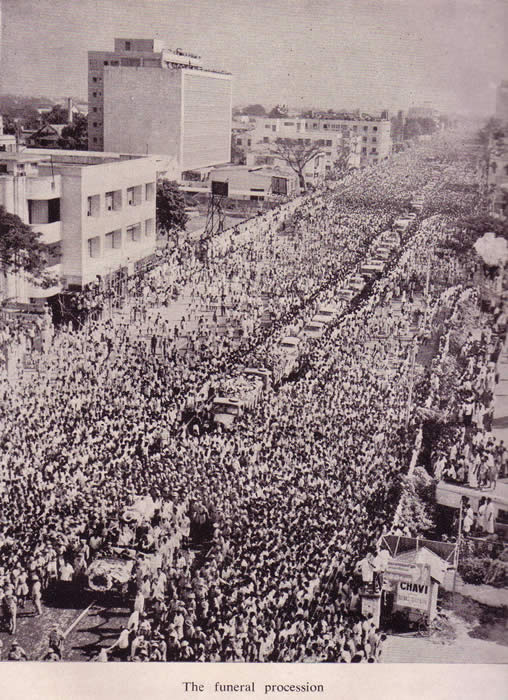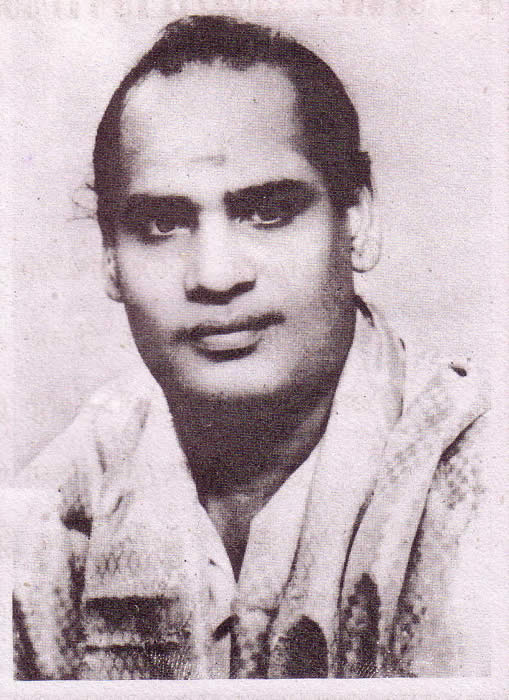Ilankai Tamil Sangam13th Year on the Web Association of Tamils of Sri Lanka in the USA |
||||||
 Home Home Archive by Date Archive by Date Archive by Category Archive by Category About the Sangam About the Sangam Engage Congress Engage Congress Multimedia Multimedia Links Links Search This Site Search This SiteEditor Not logged in yet Log in (8 unreviewed) |
Anna’s Birth Centennial AnthologyPart 1: Poet Kannadasan’s lamentby Sachi Sri Kantha
That polymath Conjeepuram Natarajan Annadurai (Anna, 1909-1969) has been badly served by the infighting of his beloved thambis (lieutenants) is a curse to befall the Tamils. One usurped the reins of DMK, by back-stabbing the designated heir apparent. Another one, peeved by the power and stronghold of the usurper, then left the party founded by Anna, and established his own party, tagging to it Anna’s name as a moniker. A few others, like poet Kannadadasan (1927-1981), who had parted company with Anna while he was alive, occasionally lamented on the magnanimity of Anna. This being the birth centenary year of Anna and the 60th anniversary year of the founding of DMK by him, I bring to the limelight some items and issues that have eluded the Anna scholars.
Poet Kannadasan’s Lament I begin this Anna’s birth centennial anthology series, with Kannadasan’s lament on the last days of Anna, and what he had watched first hand. This material appears in the volume 2 of Kannadasan’s posthumously published autobiography Mana Vaasam (1988) in Tamil. I have translated into English Chapter 28, entitled ‘Ithu Thaan Jathakam’ (This is the Horoscope, pp. 192-197). Kannadasan modestly addressed himself in third person singular in Tamil, ‘Avan’ (He). Kannadasan’s passing reference to ‘another person’ in this memoir is self-explanatory and refers to the current Tamil Nadu chief minister Karunanidhi.
For comparison, I provide Karunanidhi’s version on how he succeeded Anna as the DMK leader in 1969 from his autobiography, Nenjukku Neethi (vol.1, 1985, 2nd ed., pp. 751-752). Here is its English translation:
Kindly make note that the events and the roles played by MGR and Nedunchezhiyan as described by Kannadasan, do not appear in Karunanidhi’s version. Mohana Muhari and a Musical Glimpse of Anna
The following anecdote, I recorded as a brief feature in a note that appeared in the Sudar(Colombo) magazine in Oct. 1980. Unfortunately, I cannot recollect the original source of this authentic anecdote, mentioned in my note of Oct. 1980. And I also don’t have a copy of my Sudar note with me now to verify the original source. I have no doubt that it’s an authentic story, since as a fan of Karnatic music, I enjoyed its appeal as it featured one of my favorite singers Chidambaram S. Jayaraman, a brother-in-law of Karunanidhi. Jayaraman’s inimitable tremolo voice is well known to Tamils, for its scintillating nuances and resonance. His enunciation of Tamil words had a mystic charm and grace. He even had a title Tamil Isai Chittar (Tamil Music Mystic). Though his voice can amply depict any mood, Jayaraman was considered as an exponent in eliciting profound pathos. His countless Tamil movie songs of 1940s and 1950s, that remain popular even now, attest to this fact. Since he was considered as a DMK pillar, in those days Jayaraman was not permitted to give music concerts in Ceylon. If memory serves, Jayaraman visited Colombo in 1968 at the invitation of then Ceylon Broadcasting Corporation’s ghatam artist Guruvayoor K.K. Atchuthan master merely as a ‘tourist’, but was not allowed to give concerts! Mohanam and Muhari are two well known ragas in the Karnatic Music lexicon and have entered the Tamil language as separate idioms. While Mohanam represents the joy mood, Muhari symbolizes the pathos. Once Anna thought of a caption ‘Mohana Muhari’ for one of his columns. Just being practical minded, he requested to hum the ascension notes of Mohana raga and decension notes of Muhari raga, to Chidambaram Jayaraman, who was nearby. Jayaraman, was astounded when he hummed the ascension-decension notes of the two ragas in a combinatorial mode. Anna had created a new raga – Mohana Muhari, not recorded in the Karnatic Music lexicon. Jayaraman then pleaded to Anna in banter, ‘Anna – you better limit your range to oratory, prose and drama. Just leave the music to us. If not, you’ll make us starve.’ That banter of Chidambaram Jayaraman – a master singer, stage-movie actor and a music director of repute – was Anna’s pleasure to enjoy.
Anna’s Point-Pedro Connection That atheist and social reformer E.V. Ramasamy Naicker (1879-1973) was Anna’s mentor is well known to many. But, before Naicker, that Anna had a theist mentor and beneficiary at college is not that well known. Anna was a student at the Pachiyappa’s College, Chennai, from 1928 to 1933. The principal of Pachiyappa’s College at that time was one K. Chinnatambi Pillai (1860 - ?). About this principal, little is known or remembered now, though he might have played the Socrates role to Anna’s Plato. But that Chinnatambi Pillai was from Point Pedro has been recorded. I learnt about this educationist, from a short entry in S. Arumugam’s collection, A Dictionary of Biography of Ceylon Tamils (London, 1996, p. 38). It is as follows:
From a website dedicated to Anna (http://arignaranna.info/), a few descriptions appear about principal Chinnatambi Pillai. One contemporary teacher at the college in the late 1920s, C. Ramachandran, noted that “Mr. C. Chinnatambi Pillai, was the Principal with sacred ash and sandal wood paste displayed prominently on his forehead.” Another teacher named Prof. Krishnamurthy had recollected: “I still remember the school principal’s reference to Anna: ‘This youth has a bright future. He will be the leader of hundreds of thousands of folks, and he will revolutionize this land…’” As the story goes, Anna had passed the intermediate exam in first class. The principal, Chinnatamby Pillai wished to have Anna enrolled in the B.A. honours class. But due to limited family means, Anna wished to enroll in the ordinary B.A. class and graduate in two years, to take some kind of a job to support his family. A three year study was needed to complete the B.A. honours degree. The principal influenced Anna’s mind positively with the allure that he would make special provisions for Anna’s free education and thus made Anna to complete the B.A. honours degree. That the well-meaning timely assist of mentor Chinnatamby Pillai was a gift that changed young Anna’s career cannot be doubted. Observers could note that the brand of atheism adopted and popularized by Anna in the late 1930s and 1940s differed from that of his political mentor Periyar, by a degree or two. This variance can be attributed to the influence of Anna’s theist mentor Chinnatambi Pillai at Pachaiyappa College. *****
|
|||||
|
||||||

